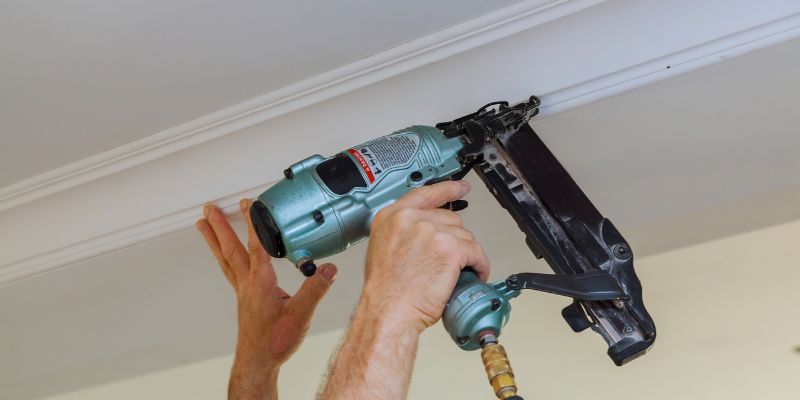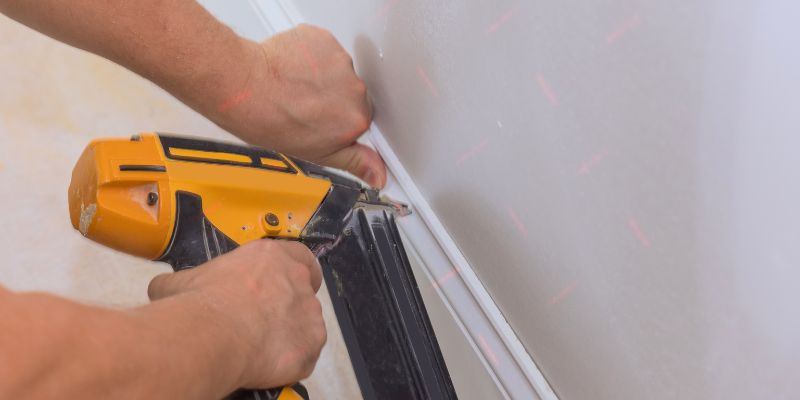Brad nails in size 15 to 18 gauge are typically used for baseboards. Baseboards serve as a finishing touch to interior spaces, covering the joint between the floor and the wall.
When installing baseboards, it is important to use the right size of nails to ensure a secure and durable attachment. Brad nails in sizes 15 to 18 gauge are commonly used for this purpose. These nails are thin and have small heads, which makes them less likely to split the wood.
The length of the nails will depend on the thickness of the baseboard material and the type of wall it will be attached to. Choosing the correct size of brad nails will help achieve a professional and long-lasting result.
Choosing The Right Size Brad Nails
When it comes to installing baseboards, choosing the right size brad nails is crucial. The size of the brad nails you use will impact the overall strength and durability of the installation. In this section, we will discuss the factors to consider when selecting brad nail size, ensuring a secure and long-lasting baseboard installation.
Understanding Brad Nail Sizing
Before diving into the factors to consider, it’s important to have a clear understanding of brad nail sizing. Brad’s nails are categorized by their length and gauge. The length refers to the overall length of the nail, while the gauge represents the thickness or diameter of the nail. Common brad nail lengths range from 5/8 inch to 2 inches, and the gauge typically varies between 15 and 18. It’s important to choose a brad nail size that matches the thickness of your baseboard and the material you are nailing into.
Factors To Consider When Selecting Brad Nail Size
There are several factors that you should take into consideration when determining the appropriate brad nail size for your baseboard installation. These factors include:
- The thickness of the Baseboard: The thickness of the baseboard will dictate the length of the brad nails you should use. It’s important to choose nails that are long enough to penetrate through the baseboard and into the underlying wall or trim.
- Material of the Baseboard: Different materials require different nail sizes. For example, softer woods may require shorter nails to prevent splitting, while harder materials like MDF may benefit from longer nails for added stability.
- Wall or Trim Material: Consider the material you are nailing into. For thin walls or delicate trim, shorter nails with a smaller gauge may be more suitable to avoid causing damage.
- Desired Holding Power: The size of the brad nail will also impact its holding power. If you are looking for a stronger and more secure installation, opting for longer nails with a larger gauge can provide added strength.
By taking these factors into consideration, you can confidently select the right size brad nails for your baseboard installation. Remember, using the correct size will ensure a secure and professional-looking finish that will stand the test of time.

Determining The Appropriate Brad Nail Length
When installing baseboards, choosing the right brad nail length is crucial to ensure a secure and professional-looking finish. The length of the nail will depend on the thickness and material of the baseboard. In this section, we will discuss the factors to consider when determining the appropriate brad nail length for your baseboard installation.
Baseboard Thickness And Material
The thickness and material of your baseboard will play a significant role in determining the correct brad nail length to use. Baseboards come in various thicknesses, typically ranging from 3/8 inch to 3/4 inch. Additionally, they can be made from different materials such as MDF (medium-density fiberboard), solid wood, or composite materials. It is important to take these factors into account to ensure the nails hold the baseboard firmly in place.
Nail Length Recommendations For Different Baseboard Types
Depending on the type of baseboard you are working with, there are specific nail length recommendations that you should follow. Here are some general guidelines:
- MDF Baseboards: For 3/8 inch to 1/2 inch MDF baseboards, a nail length of 1 inch to 1 1/4 inches is recommended. If you are working with thicker MDF baseboards (3/4 inch), opt for longer nails in the range of 1 1/2 to 2 inches.
- Solid Wood Baseboards: Solid wood baseboards are typically thicker and require longer brad nails for a proper installation. For 3/4 inch solid wood baseboards, use nails ranging from 2 to 2 1/2 inches in length.
- Composite Baseboards: Composite baseboards often have a similar thickness to MDF baseboards. Therefore, you can follow the same guidelines mentioned earlier for MDF baseboards of the corresponding thickness.
Remember, these recommendations are general guidelines and may vary based on the specific baseboard manufacturer’s recommendations or your desired level of sturdiness. It is always a good idea to consult the manufacturer’s guidelines before proceeding with your installation.
Ensuring Smooth Baseboard Installation
When installing baseboards, using the right size brad nails is crucial for ensuring a smooth and secure installation. Brad’s nails are thin, small nails that are ideal for attaching baseboards to walls without splitting or damaging the wood. By understanding the proper size and placement of brad nails, you can achieve a professional finish while avoiding common pitfalls during the installation process.
Tips For Proper Brad Nail Placement
Proper placement of brad nails is essential for a secure and seamless baseboard installation. When positioning the nails, it’s vital to ensure that they penetrate the baseboard and securely attach it to the wall, providing a sturdy hold. Utilize a nail gun or hammer to delicately drive the nails into the baseboard, understanding the appropriate positioning and force required for each nail.
Avoiding Splitting And Cracking
One of the most common issues during baseboard installation is the splitting or cracking of the wood. To prevent this, select the correct size of brad nails that are long enough to penetrate through the baseboard and into the wall without causing damage. Additionally, pre-drilling pilot holes can reduce the risk of splitting, ensuring a smooth and flawless finish.
Key Considerations For Nail Guns
When choosing the right nail gun for baseboards, consider the appropriate size of brad nails. The size of the nails should match the thickness of the baseboard, typically ranging from 15 to 18 gauge. Ensure the nail gun you select is compatible with the specific brad nail size for a secure and professional finish.
Compatibility With Brad Nails
When it comes to choosing the right size of brad nails for your baseboard installation, one of the key considerations is the compatibility of your nail gun with brad nails. Different nail guns are designed to accommodate specific sizes of brad nails, and using the wrong size can result in a poor-quality finish or, even worse, damage to your baseboards.
Before you start your baseboard project, check the manufacturer’s guidelines or user manual for your nail gun to verify the acceptable brad nail sizes. These guidelines will provide you with valuable information on the range of brad nail sizes that are compatible with your nail gun. Paying attention to this detail ensures that you choose the correct size of brad nails for your specific nail gun model.
Adjusting Nail Depth For Baseboard Applications
In addition to compatibility, another important consideration is the ability to adjust the nail depth for baseboard applications. Proper nail depth adjustment ensures that the brad nails are driven just deep enough to secure the baseboard firmly to the wall without damaging the surface. Too shallow and the nails may not hold the baseboard securely while driving them too deep can result in visible nail heads or, worse, split the baseboard.
Many nail guns offer depth adjustment features that allow you to control the depth at which the brad nails are driven into the baseboard. This feature is especially beneficial when working with different types of baseboard materials, as each material may require a different nail depth for optimal results.
When using a nail gun for baseboard applications, always test the depth setting on a scrap piece of baseboard before moving on to the actual installation. This allows you to fine-tune the nail depth and ensure that it is set correctly for your specific baseboard material.
Finishing Touches And Additional Tips
When it comes to installing baseboards, choosing the right brad nail size is crucial. However, there are a few other finishing touches and additional tips you need to consider to ensure a stunning and stable result. In this section, we will discuss two important aspects – “Choosing the Right Nail Gauge” and “Enhancing Aesthetics and Stability with Proper Nail Spacing.”
Choosing The Right Nail Gauge
One of the first things you need to consider is the nail gauge. The gauge refers to the thickness of the nail, and it plays a significant role in determining the strength and stability of the baseboard installation. The standard gauge sizes for brad nails used in baseboard installation range from 15 to 18.
Here’s a quick breakdown of the recommended nail gauge for different baseboard materials:
| Baseboard Material | Recommended Nail Gauge |
|---|---|
| Softwood or MDF | 15 or 16 |
| Hardwood | 16 or 18 |
Enhancing Aesthetics And Stability With Proper Nail Spacing
Another important factor to consider when installing baseboards is the spacing between the nails. Proper nail spacing not only ensures a visually pleasing result but also enhances the stability of the baseboard.
Here are some tips to help you achieve the perfect nail spacing:
- Space nails approximately 16 inches apart along the length of the baseboard for optimal stability.
- Avoid placing nails too close to the edges or corners of the baseboard to prevent splitting.
- Consider using a nail gun or brad nailer with a depth adjustment feature to control the nail depth, ensuring the nails are flush with the surface.
- If using a hammer, be mindful of the force applied to prevent denting or damaging the baseboard.
By following these tips and considering the right nail gauge and spacing, you can achieve a professional-looking baseboard installation that adds a touch of elegance and stability to your home.

Frequently Asked Questions For What Size Brad Nails For Baseboard
Can You Use 18 Gauge Brad Nails For Baseboards?
Yes, you can use 18 gauge brad nails for baseboards. They are sturdy enough to hold the baseboards in place securely.
Should I Use 18 Or 16 Gauge Nailer For Baseboards?
Use an 18-gauge nailer for baseboards as it provides better support and strength. It ensures a secure and durable installation, preventing future damage or loosening.
What Gauge Brad Nail Is Best For Trim?
The best gauge brad nail for trim is usually 18 or 16. These sizes offer good holding power without splitting the trim.
What Size Brad Nails Do I Need For Trim?
For trim work, use brad nails that are 18-gauge and 1. 25 to 1. 5 inches long.
Conclusion
Choosing the right size brad nails for baseboard installation is crucial for a seamless finish. By considering factors like baseboard thickness and material, you can ensure a secure and professional result. Understanding the importance of Brad nail sizes will help you achieve a durable and visually appealing baseboard installation that lasts.


